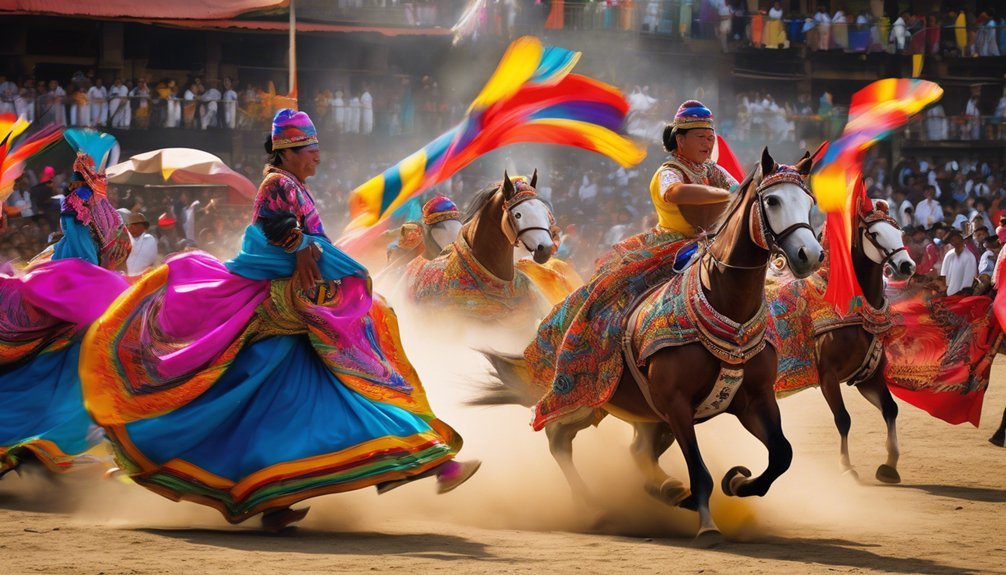
Picture a swift cavalry charge, a blur of hooves and valor that could decide the fate of a battlefield. Throughout history, horseback riding has shaped military strategy, providing unmatched speed and maneuverability. Its impact extends beyond mere logistics; it influences morale and tactics in profound ways. As you explore this intricate relationship, consider how the evolution of cavalry has transformed warfare and what this means for future military operations.
Key Takeaways
- Horseback riding enhances mobility, allowing cavalry to outmaneuver infantry and execute rapid assaults on enemy positions.
- Cavalry units can perform effective reconnaissance, providing critical strategic insights about enemy formations and movements.
- The psychological impact of mounted troops can intimidate opposing forces, disrupting their formations and reducing morale.
- Integration of equine logistics supports supply transport in challenging terrains, ensuring operational efficiency in remote military operations.
- Ongoing training and care for horses are essential for maintaining their health and performance, directly impacting mission success.
Historical Origins of Cavalry Units

The cavalry, a pivotal component of military strategy, has roots that stretch back to ancient civilizations.
You'll find that various horse breeds were harnessed for their unique strengths, enabling armies to develop effective cavalry formations. The swift Arabian horse, for instance, was ideal for speed and agility, while heavier breeds like the Clydesdale supported the need for power and endurance.
As military tactics evolved, so did the organization of cavalry units; from shock troops in the front lines to scouts gathering intelligence. These formations significantly influenced battle outcomes, showcasing the importance of horses in warfare.
Understanding these historical origins reveals how cavalry units shaped military strategies, emphasizing their enduring legacy in combat history.
The Role of Horseback Riding in Ancient Warfare
In ancient warfare, horseback riding provided critical mobility and speed advantages that transformed battlefield dynamics.
You'll notice how cavalry units executed flanking maneuvers and rapid assaults, often outpacing infantry and disrupting enemy formations.
Analyzing these tactics reveals the strategic importance of mounted troops in shaping military outcomes.
Mobility and Speed Advantages
Horseback riding revolutionized mobility in ancient warfare, offering armies a decisive edge over their foot-bound counterparts. With the ability to traverse vast terrains quickly, cavalry units could execute tactical maneuvers that foot soldiers simply couldn't match. This mobility transformed battlefield dynamics, allowing forces to outflank and surprise opponents.
| Advantage | Description | Impact on Warfare |
|---|---|---|
| Speed | Rapid movement across terrain | Outmaneuvering enemy forces |
| Versatility | Adaptable to various battlefield roles | Enhanced strategic options |
| Logistics | Efficient transport of troops | Strengthened supply lines |
The integration of equine logistics into military strategy not only improved speed but also allowed for innovative tactics that shaped the outcomes of conflicts throughout history.
Cavalry Tactics and Strategies
Cavalry tactics and strategies emerged as a direct response to the mobility advantages provided by horseback riding.
You'd find that effective cavalry formations, such as the wedge or flanking maneuvers, maximized impact during engagements. By concentrating forces at critical points, you could break enemy lines and disrupt formations.
Mounted reconnaissance played a crucial role, allowing commanders to gather intelligence and assess battlefield conditions swiftly. This agility not only enhanced strategic planning but also enabled rapid responses to shifting threats.
Ultimately, the integration of cavalry in warfare revolutionized tactics, emphasizing speed and versatility. By understanding these principles, you'll appreciate how horseback riding shaped military outcomes throughout history, ensuring that cavalry remained a vital component in ancient warfare.
Evolution of Cavalry Tactics Through the Ages
When you examine the evolution of cavalry tactics, you see a clear transformation from the straightforward charges of ancient warfare to the more nuanced strategies employed in modern military operations.
Early cavalry units relied heavily on shock value and mobility, while contemporary adaptations focus on integration with technology and combined arms tactics.
Understanding this progression highlights how the role of horseback riding in military strategy has continuously adapted to meet the demands of changing battlefields.
Ancient Warfare Strategies
Throughout history, the evolution of cavalry tactics has significantly influenced ancient warfare strategies, as mounted troops provided mobility and speed that foot soldiers could rarely match.
Chariot warfare emerged as a dominant tactic, enabling armies to strike swiftly while maintaining distance from enemy forces. The use of chariots allowed for both shock value and maneuverability on the battlefield.
Additionally, mounted archers played a crucial role, combining the advantages of horseback riding with archery. They could shoot while moving, harrying enemy formations and disrupting their tactics.
This blend of speed, mobility, and ranged attack shaped the outcomes of numerous battles, showcasing the transformative power of cavalry in ancient warfare. You can see how these strategies laid the groundwork for future military innovations.
Modern Cavalry Adaptations
As the landscape of warfare evolved, so too did the role of mounted troops, adapting to technological advancements and changing battlefield dynamics.
Modern cavalry has transformed significantly, integrating tactical innovations to enhance effectiveness. Here are four key adaptations:
- Mobility and Speed: Modern cavalry units leverage faster, more agile mounts, ensuring rapid response in dynamic environments.
- Combined Arms Operations: They work seamlessly with infantry and armored units, allowing for coordinated strikes and support.
- Intelligence Gathering: Mounted troops now often engage in reconnaissance, utilizing their mobility to gather vital information.
- Technology Integration: Modern cavalry incorporates drones and advanced communication systems, enhancing situational awareness and decision-making on the battlefield.
These adaptations illustrate how modern cavalry remains a vital component of military strategy, continually evolving to meet contemporary challenges.
Key Battles Influenced by Horseback Riding
Although many factors contribute to the outcomes of military engagements, horseback riding has undeniably shaped key battles throughout history. Cavalry charges often turned the tide, as seen in the Battle of Agincourt, where mounted troops disrupted enemy formations. Similarly, the use of mounted reconnaissance was crucial during the Napoleonic Wars, allowing commanders to gather vital intelligence on troop movements.
| Battle | Key Influence |
|---|---|
| Battle of Agincourt | Effective cavalry charges disrupted formations |
| Battle of Waterloo | Mounted reconnaissance provided strategic insights |
| Mongol Conquests | Fast cavalry tactics overwhelmed larger armies |
These examples illustrate how horseback riding not only enhanced mobility but also fundamentally altered strategies, shaping the very fabric of warfare.
Modern Military Applications of Equine Mobility
While many might associate modern warfare with advanced technology, equine mobility still plays a vital role in military operations today. The integration of equine technology into mounted logistics enhances operational efficiency, particularly in challenging terrains where vehicles may struggle.
Here are four key applications:
- Rapid Reconnaissance: Horses can navigate difficult landscapes stealthily, providing valuable intelligence.
- Supply Transport: Equines can carry essential supplies to remote locations, circumventing logistical bottlenecks.
- Search and Rescue: Their agility enables swift responses in emergencies, reaching areas inaccessible to mechanized units.
- Cavalry Units: Modern cavalry, utilizing advanced equine technology, can execute maneuvers that are both strategic and impactful.
Training and Skills Required for Effective Mounted Operations

Effective mounted operations demand a unique set of training and skills that ensure both the rider and the horse can perform optimally in various military scenarios.
You'll need to develop mounted skills through rigorous tactical training, focusing on rider coordination and equine management. Combat readiness hinges on your ability to execute mobility drills and endurance exercises, which enhance both your stamina and that of your horse.
Discipline development is crucial; it fosters trust and communication between you and your mount. Additionally, understanding horse care is vital for maintaining your horse's health and performance.
Finally, teamwork dynamics play a significant role in mounted operations, where synchronized movements can make the difference between success and failure in the field.
The Psychological Impact of Cavalry on Opposing Forces
The presence of cavalry on the battlefield can significantly influence the morale and psychological state of opposing forces. This impact often manifests through psychological warfare, where the sight and sound of mounted troops can incite fear and uncertainty.
Here are four key effects you might observe:
- Intimidation: The sheer size and speed of cavalry can create a sense of dread among enemy troops.
- Disruption: Mounted units can disrupt enemy formations, causing panic and confusion.
- Lowered Troop Morale: The knowledge of facing cavalry can demoralize opposing soldiers, diminishing their fighting spirit.
- Increased Pressure: The looming presence of cavalry forces opponents to react defensively, often leading to mistakes.
Understanding these dynamics helps you appreciate the cavalry's role beyond mere physical presence in military strategy.
Future of Horseback Riding in Military Contexts
As military strategies evolve in response to technological advancements, the role of horseback riding in military contexts is poised for reevaluation.
You'll find that the future of equestrian tactics hinges on effective technological integration, balancing modern warfare with traditional cavalry capabilities. The adaptability of mounted units can still provide unique advantages, such as mobility in rugged terrains and fostering troop cohesion.
Importantly, equine welfare must remain a priority; ethical considerations in the treatment and training of horses will shape their continued use in military operations.
Frequently Asked Questions
What Breeds of Horses Are Preferred for Military Operations?
For military operations, you'd prefer breeds like Arabian horses for their endurance and adaptability, alongside Thoroughbred performance horses for speed and agility. These traits enhance effectiveness in various tactical situations on the battlefield.
How Do Soldiers Maintain Their Horses During Deployment?
Like a well-tuned machine, you prioritize horse care during deployment. You ensure proper equine nutrition, manage grooming routines, and monitor health closely, creating a bond that enhances performance and keeps your horse ready for action.
What Are the Costs Associated With Maintaining a Cavalry Unit?
Maintaining a cavalry unit involves significant costs. You'll face cavalry training expenses, including personnel and instruction, alongside equipment expenses for saddles, bridles, and maintenance. Budgeting for feed and veterinary care is essential too.
Are There Psychological Benefits for Soldiers Riding Horses?
As you ride, the rhythmic hoofbeats echo in your mind, offering stress relief. This bond with your horse enhances teamwork dynamics, fostering trust and camaraderie, ultimately strengthening your psychological resilience in challenging situations.
How Do Modern Technologies Impact Horseback Riding in the Military?
Modern technologies, like drone integration and enhanced tactical communication, reshape horseback riding's role in the military. You'll find that these advancements improve coordination, allowing cavalry units to operate more effectively alongside modern warfare strategies.
Conclusion
In conclusion, horseback riding has shaped military strategy throughout history, proving essential for mobility, reconnaissance, and psychological warfare. For instance, during the Battle of Agincourt in 1415, English longbowmen used terrain and dismounted cavalry to outmaneuver French forces, showcasing how equine agility can alter battle outcomes. As modern warfare evolves, understanding the historical significance of cavalry can inform future strategies, ensuring that the lessons of the past remain relevant in today's military contexts.





